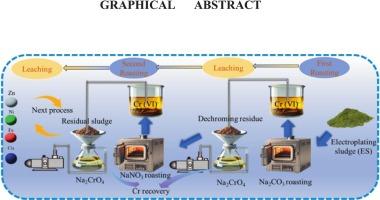用两步焙烧法从电镀污泥中高效回收铬:机理和动力学
IF 5
2区 工程技术
Q1 ENGINEERING, CHEMICAL
引用次数: 0
摘要
电镀污泥是一种危险的工业废弃物,其成分复杂、铬含量高、环境毒性大,对其进行高效处理已成为迫切需要。为了解决这一问题,采用了一种新的两步焙烧工艺- na2co3焙烧与水浸进行初始脱铬,然后对残留物进行NaNO3焙烧-从ES中回收铬。考虑到ES组分的复杂性,利用FactSage (Facility for Analysis of Chemical Thermodynamics)对焙烧过程的热力学行为和相变进行了预测。在此基础上,在500 ~ 1000℃的温度范围内进行了焙烧实验,并通过矿物解出分析(MLA)和x射线衍射(XRD)分析验证了焙烧过程中的相变机理。结果表明,在最佳两步焙烧工艺条件下,Cr的总回收率可达99%。此外,本研究阐明了ES中系统的cr -相变机制,从氢氧化物形成开始,然后转变为氧化物,尖晶石相(FeCr2O4, MgCr2O4, ZnCr2O4和CaCr2O4),最后转化为可溶性Na2CrO4。动力学分析进一步表明,Na2CO3焙烧过程中Cr(III)的氧化遵循产物层扩散机制,表观活化能为44.5 kJ/mol,在500 ~ 800℃之间与缩核模型具有较强的线性相关性(R2 > 0.99),在较高温度下出现烧结诱导的扩散限制。总体而言,本研究系统地阐明了两步焙烧过程中Cr的相变机理,为工业危险废弃物中Cr的高效、环境可持续回收提供了理论见解和实践指导。本文章由计算机程序翻译,如有差异,请以英文原文为准。

Efficient recovery of chromium from electroplating sludge by a two-step roasting process: Mechanisms and kinetics
Electroplating sludge (ES), a hazardous industrial waste, poses environmental challenges due to its complex composition, high chromium (Cr) content, environmental toxicity, and its efficient treatment has become a pressing necessity. To address this issue, a novel two-step roasting process—Na2CO3 roasting with water leaching for initial dechroming, followed by NaNO3 roasting of the residue—was used to recover chromium from ES. Given the compositional complexity of ES, FactSage (Facility for the Analysis of Chemical Thermodynamics) was utilized to predict the thermodynamic behavior and phase transformation of the roasting process. Based on the prediction, roasting experiments were carried out at temperatures ranging from 500 to 1000 °C, and the phase transformation mechanisms during the roasting processes were verified by mineral liberation analysis (MLA) and X-ray diffraction (XRD) analysis. Results reveal that the total recovery efficiency of Cr reached 99 % under the optimal conditions of the two-step roasting process. Moreover, this study elucidated a systematic Cr-phase transition mechanism in ES, beginning with hydroxide formation, followed by transformation into oxides, spinel phases (FeCr2O4, MgCr2O4, ZnCr2O4, and CaCr2O4), and finally conversion into soluble Na2CrO4. Kinetic analysis further indicated that Cr(III) oxidation during Na2CO3 roasting followed a product-layer diffusion mechanism with an apparent activation energy of 44.5 kJ/mol, supported by a strong linear correlation to the shrinking core model (R2 > 0.99) between 500–800 °C, while sintering-induced diffusion limitations emerged at higher temperatures. Overall, this work systematically clarified the Cr phase transformation mechanisms during the two-step roasting, offering theoretical insights and practical guidance for high-efficient and environmentally sustainable recovery of Cr from hazardous industrial wastes.
求助全文
通过发布文献求助,成功后即可免费获取论文全文。
去求助
来源期刊

Minerals Engineering
工程技术-工程:化工
CiteScore
8.70
自引率
18.80%
发文量
519
审稿时长
81 days
期刊介绍:
The purpose of the journal is to provide for the rapid publication of topical papers featuring the latest developments in the allied fields of mineral processing and extractive metallurgy. Its wide ranging coverage of research and practical (operating) topics includes physical separation methods, such as comminution, flotation concentration and dewatering, chemical methods such as bio-, hydro-, and electro-metallurgy, analytical techniques, process control, simulation and instrumentation, and mineralogical aspects of processing. Environmental issues, particularly those pertaining to sustainable development, will also be strongly covered.
 求助内容:
求助内容: 应助结果提醒方式:
应助结果提醒方式:


